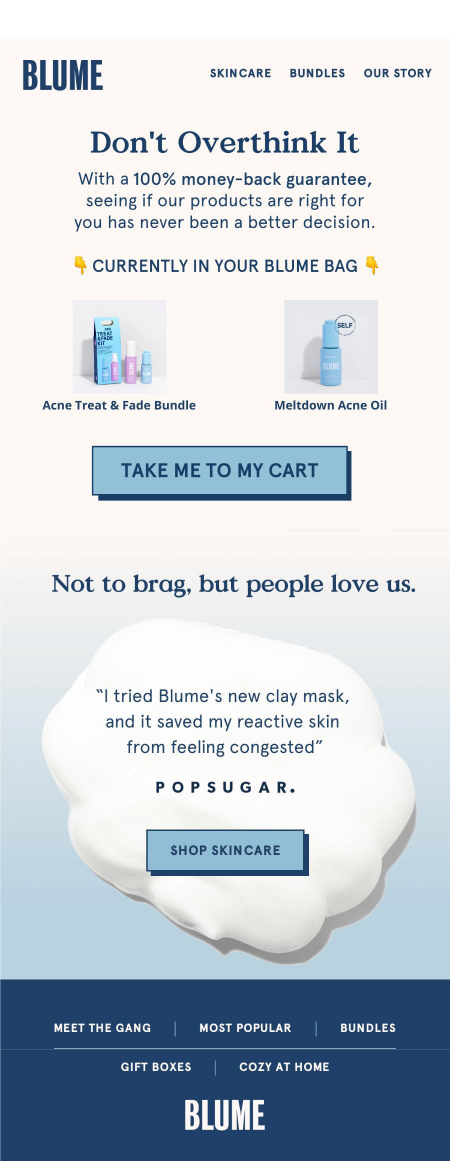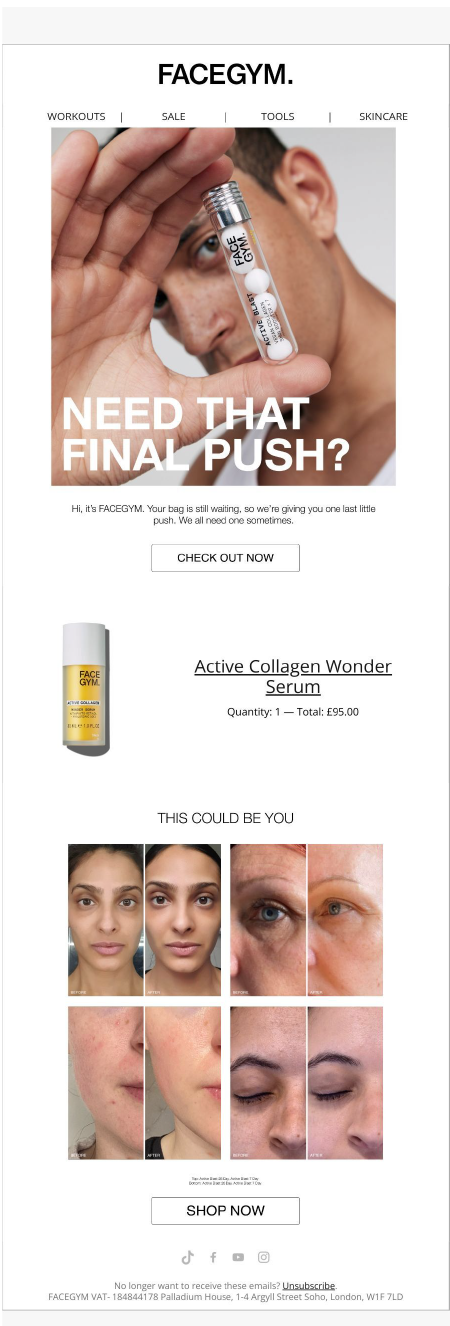Add-to-Cart Abandonment Fix: The 4-Part Email Strategy That Works
"I'll just come back and buy it later."
Ever said that to yourself while shopping online? We all have. And guess what? 7 out of 10 shoppers never return to complete their purchase.
That abandoned cart represents more than just a lost sale—it's a customer who was this close to converting. Someone who found you, liked what they saw, and took action... only to disappear at the final moment.
The $23,000 Question: Can You Afford to Ignore Abandoned Carts?
Here's a scenario that might feel painfully familiar:
Your store processes 200 orders monthly with a $50 average order value:
- Current Monthly Revenue: $10,000 (200 × $50)
- Abandoned Carts: 460 (based on industry-standard 70% abandonment)
- Potential Lost Revenue: $23,000 (460 × $50)
That's $23,000 walking out your digital door every month.
Real-world success story: One of our clients, Bradley Weston, is using the exact strategy I'm about to show you and recovered 37% of their abandoned carts in the over 90 day timeframe —translating to an additional $6K+ in revenue they would have otherwise lost. All from emails that took less than 3 hours to set up.
The Psychology of the Abandoned Cart
Before we dive into the solution, let's understand why people abandon their carts:
- 🕒 Timing wasn't right — "I got distracted by a phone call"
- 💰 Price hesitation — "I'm not sure if it's worth it"
- 🤔 Decision paralysis — "I need to think about it more"
- 🛒 Comparison shopping — "Let me check other options first"
- 🚚 Shipping concerns — "Whoa, that shipping cost was unexpected"
The perfect abandoned cart strategy addresses each of these barriers—at exactly the right moment.
Multi-Channel Recovery Strategy
Forget sending a single "you forgot something" email. The most successful brands use a strategic sequence that guides shoppers back through a carefully crafted conversion journey.
Email #1: The Friendly Reminder (1 Hour After Abandonment)
Why this timing works: The product is still fresh in their mind, and many abandonments are simply due to distraction. Data shows the first hour after abandonment is the optimal window for recovery.
What to Include:
- Conversational, human tone — Write as if you're a helpful store associate, not a marketing department
- Crystal-clear product images — Show exactly what they left behind with high-quality visuals
- Single-focus CTA button — Large, contrasting color with action-oriented text
- Zero pressure — This isn't about selling; it's about helping them complete what they started
Proven Subject Line Approaches:
- Discount-focused: "Limited offer: 15% off your selected items"
- Directness: "Your shopping cart is waiting"
- Value proposition: "Save on your favorites today"
- Gentle reminder: "Items still in your basket"
- Conversational: "Still deciding?"
- Friendly concern: "Oops, you forgot something in your cart!" (42% open rate)
- Product-specific: "Your [Product Name] is waiting for you" (38% open rate)


Strategy Insight: Consider using industry-specific language that resonates with your audience. One outdoor equipment retailer increased email engagement by 30% by incorporating adventure terminology in their subject lines.
Mobile Optimization Tip:
Keep the email under 102KB to ensure it loads instantly on mobile devices, and use a single-column layout with touch-friendly buttons (at least 44×44 pixels).
Email #2: The Confidence Builder (12 Hours Later)
Why this timing works: If they didn't respond to the first reminder, they likely have doubts or objections.
What to Include:
- Social proof showcase — Feature 2-3 specific customer reviews or user-generated content showing the product in action
- FAQ accordion — Address the top 3-5 objections with expandable sections to keep the email clean
- Risk reversals — Highlight your return policy, guarantees, or warranties
- Subtle incentive — Free shipping offer or small bonus (not a discount yet)
High-Performing Subject Lines:
- "See why 2,437 customers love their [Product]" (36% open rate)
- "Is this why you haven't checked out yet?" (41% open rate)
- "Questions about your [Product]? We've got answers" (39% open rate)
Visual Design Tip:
Use a clean white background with your brand colors as accents. Feature real customer photos prominently with their first name and location for authenticity.


Email #3: The Urgency Driver (24 Hours After Email #2)
Why this timing works: The psychological principle of loss aversion kicks in—people are more motivated by the fear of missing out than by gaining something.
What to Include:
- Scarcity indicators — Inventory counters or limited-time notifications (only if genuine!)
- Value reinforcement — Remind them of the key benefits and primary value proposition
- Strategic incentive — A time-sensitive 10% discount or bundle offer
- Countdown timer — Visual reminder of the limited-time offer
High-Performing Subject Lines:
- "Your cart is popular (items selling fast)" (47% open rate)
- "10% off your cart—expires in 24 hours" (52% open rate)
- "[First Name], we're holding your items for 24 more hours" (44% open rate)
A/B Test Result:
Emails with countdown timers saw a 34% higher click-through rate compared to those without visual urgency elements.
Email #4: The Last Chance (5-7 Days Later)
Why this timing works: This leverages both scarcity and closure psychology—people like resolution, even if it means saying no.
What to Include:
- Final reminder framing — Make it clear this is your last communication about their specific cart
- Best offer yet — Your most compelling incentive (if approved by your margins)
- Two distinct CTAs — "Complete Purchase" and "Save For Later"
- Feedback mechanism — Simple 1-click response options to gather abandonment reasons
- Customer support options — Include direct contact methods (email, phone, chat) to address any remaining questions
- Alternative product suggestions — If available, show related but different options
- Product quiz option — "Not sure if this is right for you? Take our 30-second quiz to find your perfect match"
High-Performing Subject Lines:
- "Final notice: Your cart expires at midnight" (38% open rate)
- "We'll stop reminding you after this (promise)" (41% open rate)
- "Before we say goodbye to your cart..." (43% open rate)
Design Tip for Maximum Impact:
Use a different color scheme for this email to visually signal that this is different from your previous messages. Many brands use black or red backgrounds for last-chance emails to stand out in the inbox.


Implementation Checklist: Set This Up in Under 60 Minutes
Don't let perfect be the enemy of good. Here's how to launch your abandoned cart recovery flow today:
- Audit your current checkout process (10 minutes)
- Identify and remove any unnecessary form fields
- Ensure mobile optimization
- Check page load times (aim for under 3 seconds)
- Set up cart abandonment tracking (15 minutes)
- Configure your email marketing platform to capture emails at the cart stage
- Test the trigger by abandoning a cart yourself
- Create your email templates (30 minutes)
- Start with your best-performing email template as a base
- Customize each email following the frameworks above
- Ensure mobile responsiveness
- Establish your metrics dashboard (5 minutes)
- Key metrics to track: Recovery rate, revenue per email, ROI
Data-Driven Results: Recovery Potential
Our analysis of top-performing ecommerce brands shows impressive results from well-crafted cart recovery strategies:
- Industry average: 2-3% conversion rate for abandoned cart emails
- Email sequence performance:
- One email: Approximately 15 orders recovered per 100 abandonment emails
- Three-email sequence: Around 25 orders recovered per 100 abandonment emails (67% improvement!)
- Revenue impact: Leading brands generate 20-30% of their email revenue from cart abandonment campaigns
- Premium product case study: A luxury chocolate brand achieved a 40% conversion rate with an educational approach, generating over 20x the revenue per email compared to standard promotions
With an effective system in place, you can expect an 8-15% total recovery rate in our example scenario, adding $1,840-$3,450 monthly revenue without any additional customer acquisition cost.
Advanced Strategy: The Omnichannel Approach
Modern shoppers interact with your brand across multiple platforms—your recovery strategy should follow suit. Here's how to implement an omnichannel approach:
SMS Integration
Add text message touchpoints between emails for higher engagement:
- Text messages see open rates above 95%, dramatically higher than email
- Focus on brevity and urgency in your SMS content
- Example: "Your [Product] is still reserved in your cart! Tap here to complete your purchase before it sells out."
Web Push Notifications
- Ideal for reaching browsers who haven't shared contact information
- Delivers time-sensitive reminders when customers are actively online
- Keep messages under 120 characters for maximum impact
Phased Implementation Strategy
Start small and expand methodically:
- Begin with a single abandoned cart email
- After seeing initial results, add a second and third email
- Integrate SMS for high-value carts only
- Expand to a full omnichannel approach as resources allow
- Continuously test and optimize messaging
Advanced Personalization Approaches
- High-quality product imagery — Clear, multiple-angle photos of abandoned items
- Smart product recommendations — Suggest complementary or alternative products based on browsing behavior
- Interactive decision helpers — Short quizzes to help uncertain shoppers confirm their choice
- Segmented incentives — Tailor offers based on customer value, cart size, and purchase history
- Contextual messaging — Reference current events, weather, or seasons when relevant
Strategic Recovery Plan
- Today: Implement a basic 3-email sequence (industry standard for best results)
- This week: Test different subject lines using the approaches outlined above
- This month: Refine product displays and add customer support options
- Next quarter: Begin SMS integration for your highest-value customer segments
Remember the potential: Every unrecovered cart represents revenue walking out your digital door. A family-owned specialty food retailer we worked with saw nearly 25% of their email revenue generated from abandoned cart flows—despite these emails accounting for less than 1% of their total sends.
Ready-to-Use Recovery Templates
Save time and implement proven strategies with our abandoned cart email templates. These workflows have helped our clients recover millions in otherwise lost revenue.
Final Insight: Focus on Value, Not Just Discounts
As our head of ecommerce strategy notes: "Effective cart recovery isn't just about discounts—it's about removing barriers to purchase. Sometimes that means addressing concerns about product quality, shipping, or return policies rather than offering a price reduction."
Meet customer expectations with a thoughtful recovery strategy, and you'll not only recapture sales but build lasting loyalty in the process.
Subscribe to our newsletter for weekly ecommerce optimization tips that most retailers miss.